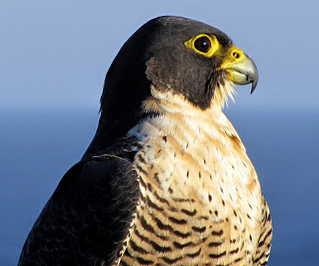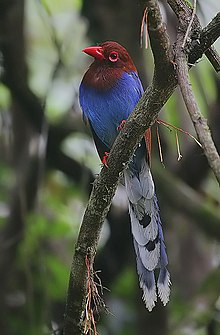
A passerine is any bird of the order Passeriformes which includes more than half of all bird species. Sometimes known as perching birds, passerines generally have an anisodactyl arrangement of their toes, which facilitates perching.

A songbird is a bird belonging to the suborder Passeri of the perching birds (Passeriformes). Another name that is sometimes seen as the scientific or vernacular name is Oscines, from Latin oscen, "songbird". The Passeriformes contains 5,000 or so species found all over the world, in which the vocal organ typically is developed in such a way as to produce a diverse and elaborate bird song.

Larks are passerine birds of the family Alaudidae. Larks have a cosmopolitan distribution with the largest number of species occurring in Africa. Only a single species, the horned lark, occurs in North America, and only Horsfield's bush lark occurs in Australia. Habitats vary widely, but many species live in dry regions. When the word "lark" is used without specification, it often refers to the Eurasian skylark (Alauda arvensis).
The Sibley–Ahlquist taxonomy is a bird taxonomy proposed by Charles Sibley and Jon E. Ahlquist. It is based on DNA–DNA hybridization studies conducted in the late 1970s and throughout the 1980s.

The Tyranni (suboscines) are a suborder of passerine birds that includes more than 1,000 species, the large majority of which are South American. It is named after the type genus Tyrannus. These have a different anatomy of the syrinx musculature than the oscines, hence the common name of suboscines.

Meliphagoidea is a superfamily of passerine birds. They contain a vast diversity of small to mid-sized songbirds widespread in the Austropacific region. The Australian Continent has the largest richness in genera and species.

Passerida is, under the Sibley-Ahlquist taxonomy, one of two parvorders contained within the suborder Passeri. While more recent research suggests that its sister parvorder, Corvida, is not a monophyletic grouping, the Passerida as a distinct clade are widely accepted.

Stenostiridae, or the fairy flycatchers, are a family of small passerine birds proposed as a result of recent discoveries in molecular systematics. They are also referred to as stenostirid warblers.

Tityridae is family of suboscine passerine birds found in forest and woodland in the Neotropics. The 45 species in this family were formerly spread over the families Tyrannidae, Pipridae and Cotingidae. As yet, no widely accepted common name exists for the family, although tityras and allies and tityras, mourners and allies have been used. They are small to medium-sized birds. Under current classification, the family ranges in size from the buff-throated purpletuft, at 9.5 cm (3.7 in) and 10 grams, to the masked tityra, at up to 24 cm (9.5 in) and 88 grams. Most have relatively short tails and large heads.

The order Falconiformes is represented by the extant family Falconidae and a handful of enigmatic Paleogene species. Traditionally, the other bird of prey families Cathartidae, Sagittariidae (secretarybird), Pandionidae (ospreys), Accipitridae (hawks) were classified in Falconiformes. A variety of comparative genome analyses published since 2008, however, found that falcons are part of a clade of birds called Australaves, which also includes seriemas, parrots and passerines. Within Australaves falcons are more closely related to the parrot-passerine clade than they are to the seriemas. The hawks, vultures and owls are placed in the clade Afroaves.

Eurylaimides is a clade of passerine birds that are distributed in tropical regions around the Indian Ocean and a single American species, the sapayoa. This group is divided into five families. The families listed here are those recognised by the International Ornithologists' Union (IOC).

Muscicapoidea is a superfamily belonging to the infraorder Passerides containing the Old World flycatchers, thrushes, starlings and their allies. The superfamily contains around 670 species.

Tyrannides is a clade of passerine birds that are endemic to the Americas. The group likely originated in South America during the Eocene, about 45 million years ago.

Psittacopasseres is a taxon of birds consisting of the Passeriformes and Psittaciformes (parrots). Per Ericson and colleagues, in analysing genomic DNA, revealed a lineage comprising passerines, psittacines and Falconiformes. The group was proposed following an alignment of nuclear intron sequences by Shannon Hackett et al. in 2008. It was formally named as Psittacopasserae in a 2011 Nature Communications article by Alexander Suh and other authors working with Jürgen Schmitz's group, based on genetic analysis of the insertion of retroposons into the genomes of key avian lineages over the course of evolution during the Mesozoic Era. This clade was defined in the PhyloCode by George Sangster and colleagues in 2022 as the least inclusive crown clade containing Psittacus erithacus and Passer domesticus.

Malaconotoidea is a superfamily of passerine birds. They contain a vast diversity of omnivorous and carnivorous songbirds widespread in Africa and Australia, many of which superficially resemble shrikes. It was defined and named by Cacraft and colleagues in 2004 and contains the bushshrikes (Malaconotidae), helmetshrikes (Prionopidae), ioras (Aegithinidae), vangas (Vangidae) and the Australian butcherbirds, magpies, currawongs and woodswallows (Artamidae). Molecular analysis in 2006 added the Bornean bristlehead to the group, though its position in the Malconotoidea is unclear. It was initially thought related to the butcherbirds and woodswallows but now is thought to be an early offshoot.

Certhioidea is a superfamily belonging to the infraorder Passerida containing wrens and their allies. It was proposed in 2004 by Cracraft and colleagues to house a clade of four families that were removed from the superfamily Sylvioidea.

Bombycilloidea is a superfamily of passerine birds that contains ten living species. They are found in North, Central America, most of the Palearctic, the Arabian Peninsula, the islands of Hispaniola and Sulawesi, and formerly the Hawaiian Islands.

Hyliidae is a family of passerine birds which contains just two species, the green hylia and the tit hylia. Physiological similarities and molecular phylogenetic studies strongly support the creation of this family.

Muscicapida is a clade of birds in the order Passeriformes. Oliveros, C.H. et al. (2019) suggested a gondwanan migration of this lineage from Australia to Eurasia.


















